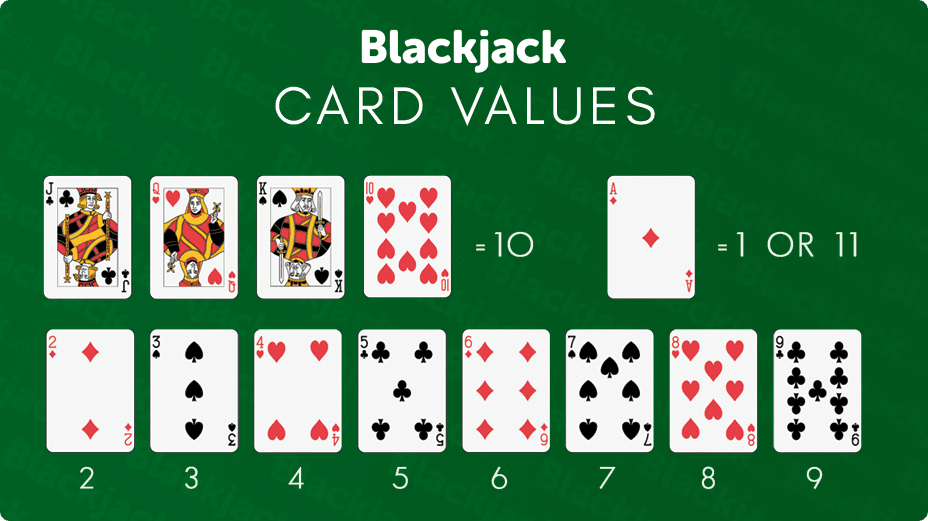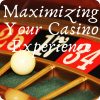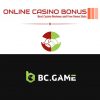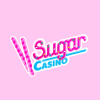What is Blackjack?
Blackjack, also known as 21, aims to beat the dealer without going over 21. To boost your odds, use a smart strategy, considering your hand and the dealer’s card. This strategy is effective in reducing the casino’s advantage and improving your winning prospects. For a comprehensive approach, commit the basic blackjack strategy chart to memory. And if you’re an experienced player, delve into card counting techniques for an even greater edge.
Hand Value Assessment:
In Blackjack, your main goal is to outscore the dealer’s hand without surpassing a total of 21 points. Players should always consider the total value of their hand, which is the sum of the card values they hold. Number cards are worth their face value, face cards (kings, queens, jacks) are worth 10 points, and aces can be worth 1 or 11 points, depending on what benefits the player.
Gameplay:
- The game typically involves one or more standard decks of 52 playing cards.
- Players are dealt two cards face-up, while the dealer receives one card face-up (upcard) and one card face-down (hole card).
In blackjack, we distinguish between two types of hands: soft hands and hard hands.
A soft hand includes an Ace valued at 11, allowing it to receive additional cards without the risk of exceeding 21. On the other hand, a hard hand is one without an Ace or one where the Ace is counted as one. If you go over 21 with your next card, you lose the round when holding a hard hand.

Player Decision:
After receiving their initial two cards, players have several options:
- “Hit”: Request another card to improve their hand’s total.
- “Stand”: Keep their current hand and decline additional cards.
- “Double Down”: Double their original bet and receive one more card, usually reserved for strong hands.
- “Split”: If dealt a pair, split the cards into two separate hands, each with its own bet, and continue playing with both hands.
- “Surrender” (not available in all variants): Forfeit half of the bet and give up the hand.
Mastering the Odds: Understanding Blackjack Probabilities for Better Gameplay
Understanding the odds and probabilities in Blackjack is crucial for making informed decisions and improving your chances of winning. Here are some key aspects of Blackjack odds and probabilities:
- Blackjack Probability Chart: A Blackjack probability chart or table provides the likelihood of various outcomes based on your initial hand and the dealer’s upcard. This tool helps players make optimal decisions in different game situations.
- Natural Blackjack (21): The probability of being dealt a natural blackjack (an Ace and a 10-value card) is approximately 4.83%. This pays out at 3:2 odds, meaning you receive 1.5 times your bet if you hit a blackjack.
- Busting Probability: One of the critical aspects of Blackjack is avoiding busting (going over 21). The likelihood of busting depends on your current hand total. For instance, if you have a hand totaling 16, the odds of busting when you hit are around 62%. Knowing these probabilities helps you decide whether to hit or stand.
- Dealer Bust Probability: The dealer’s likelihood of busting is also essential to your strategy. When the dealer’s upcard is a 4, 5, or 6, they are more likely to bust. Understanding these dealer bust probabilities can influence your decisions, such as when to double down or stand on a lower hand total.
- Splitting Pairs: When you have a pair of cards, the decision to split them can impact your odds. For example, splitting a pair of 8s against a dealer’s 6 can be a smart move because you’re capitalizing on the dealer’s increased likelihood of busting.
- Double Down Opportunities: Doubling down on certain hands can provide favorable odds. Typically, you’ll want to double down when you have a total of 10 or 11, especially if the dealer has a weak upcard.
- Insurance Bet: Understanding the odds behind the insurance bet is essential. Generally, it’s considered an unfavorable bet with a relatively high house edge, and most experienced players avoid it.
- Card Counting: Skilled players may use card counting techniques to gain an advantage by tracking the ratio of high to low-value cards left in the deck. Card counting can improve your odds significantly but requires practice and expertise.
- Shoe Size: The number of decks in play, often referred to as the “shoe size,” affects the odds. More decks typically increase the house edge, while fewer decks can be more favorable for players.
- Rule Variations: Different Blackjack variants and house rules can impact your odds. For example, games that allow doubling down on any two cards or offer late surrender can be more player-friendly.
Blackjack chance of going BUST
| Value of first two cards(not including soft hands) | Cards required to go bust | Approximate chance of going bust |
| 11 or less | N/A | 0% |
| 12 | 10, J, Q, K | 31.0% |
| 13 | 9, 10, J, Q, K | 38.6% |
| 14 | 8, 9, 10, J, Q, K | 56.2% |
| 15 | 7, 8, 9, 10, J, Q, K | 58.1% |
| 16 | 6, 7, 8, 9, 10, J, Q, K | 61.6% |
| 17 | 5, 6, 7, 8, 9, 10, J, Q, K | 69.2% |
| 18 | 4, 5, 6, 7, 8, 9, 10, J, Q, K | 76.9% |
| 19 | 3, 4, 5, 6, 7, 8, 9, 10, J, Q, K | 84.6% |
| 20 | 2, 3, 4, 5, 6, 7, 8, 9, 10, J, Q, K | 92.3% |
Dealer chance of going bust
| Dealer’s card | Approximate chance of going bust |
| 2 | 35.3% |
| 3 | 37.6% |
| 4 | 40.3% |
| 5 | 42.9% |
| 6 | 42.1% |
| 7 | 26.0% |
| 8 | 23.9% |
| 9 | 23.4% |
| 10, J, Q, K | 21.4% |
| Ace | 11.7% |
When Does the Dealer Stop Hitting in Blackjack?
Players have the freedom to draw cards as they please to build their ideal hands in blackjack. In contrast, the dealer follows strict rules regarding when to hit. The critical point is whether the dealer must hit on a soft 17. Allowing the dealer this option can provide them an advantage, enabling them to draw an extra card and potentially outdo a player’s higher hand, such as 18, 19, or 20. It even permits the dealer to split in the case of 21, unless the player has a blackjack with an Ace and a 10-valued hole card.
Understanding when the dealer stops hitting in blackjack, depending on soft and hard hands, directly influences the odds. For example, if the dealer can hit on a soft 17, the house edge increases by 0.22%. Over time, these differences can accumulate, making it preferable to seek out casinos where the dealer is obligated to stand on soft 17.
| Dealer’s final hand value | Probability |
| Blackjack | 4.8% |
| 21 (more than two cards) | 7.4% |
| 20 | 17.6% |
| 19 | 13.5% |
| 18 | 13.8% |
| 17 | 14.5% |
Here is a selection of top-rated casinos that offer an impressive variety of blackjack to enjoy: 22Bet Casino, 1xBet Casino, Betwinner Casino , Viggoslots Casino, Playfina Casino, King Billy Casino, Mozzart Casino, Pin-up Casino & 20 Bet Casino.













